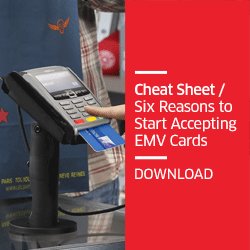Ingenico EMV FAQ
Some Facts You Need to Know About Chip-Enabled Cards
- Most banks are in the process of re-issuing all cards
- Chip cards increase security and minimize fraud for both you and your customers
- Most of your customers will have these cards by October 2015
- You can continue to accept cards via swipe
What is EMV?
EMV chip technology is becoming the global standard for credit card and debit card payments. Named after its original developers (Europay, MasterCard® and Visa®), this technology features payment instruments (cards, mobile phones, etc.) with embedded microprocessor chips that store and protect cardholder data. This standard has many names worldwide and may also be referred to as: "chip and PIN" or "chip and signature."What is chip technology?
Chip technology is an evolution in our payment system that will help increase security, reduce card-present fraud and enable the use of future value-added applications. Chip-enabled cards are standard bank cards that are embedded with a micro computer chip. Some may require a PIN instead of a signature to complete the transaction process.What makes EMV different than the traditional magnetic stripe card payment?
Simply put, EMV (also referred to as chip-and-PIN, chip-and-signature, chip-and-choice, or generally as chip technology) is the most recent advancement in a global initiative to combat fraud and protect sensitive payment data in the card-present environment. Payment data is more secure on a chip-enabled payment card than on a magnetic stripe (magstripe) card, as the former supports dynamic authentication, while the latter does not (the data is static). Consequently, data from a traditional magstripe card can be easily copied (skimmed) with a simple and inexpensive card reading device – enabling criminals to reproduce counterfeit cards for use in both the retail and the CNP environment. Chip (EMV) technology is effective in combating counterfeit fraud with its dynamic authentication capabilities (dynamic values existing within the chip itself that, when verified by the point-of-sale device, ensure the authenticity of the card).What other incentives are there to accept chip cards?
In addition to the reduction of fraud and related chargebacks, there are other cost savings associated with EMV acceptance. The payment brands are doing their part to ensure that chip-bearing customers can pay at chip-enabled businesses. For example, Visa, MasterCard, Discover and American Express have all issued upcoming rules and guidelines for processors and merchants to support EMV chip technology. The Payment Brands have introduced programs that waive a merchant’s annual PCI-DSS audit if 75 percent of the respective payment brand specific transactions are processed through a dual contact and contactless EMV certified device. Another Payment Brand ruling is the impending chip liability shift. Once this goes into effect, merchants who have not made the investment in chip-enabled technology may be held financially liable for card-present counterfeit and potentially lost and stolen fraud that could have been prevented with the use of a chip-enabled Revel pos documentation, manuals.Is this technology unique to the United States?
No. The chip technology standard for payment was first used in France in 1992. Today, there are more than 1 billion chip cards used around the world. The U.S. is one of the few industrialized nations that have not fully transitioned to this technology standard. If you already have a merchant services account with Chase and you want to upgrade your terminal, call us at 1-800- 533-4912.Why should I invest in chip card acceptance now?
Preventing the growth of card-present fraudulent activity is one of the main reasons the industry is moving toward EMV technology. Chip cards make it difficult for fraud organizations to target cardholders and businesses alike. As a result, more and more chip cards are being introduced by U.S. financial institutions in order to support and switch over to this technology. In addition, Visa, MasterCard, Discover and American Express have announced upcoming liability shifts for credit card transactions based on this standard. Any merchants or issuers who do not support chip technology may be liable for the cost of counterfeit fraud. The term “Liability Shift" refers to the change in who bears the chargeback related cost of fraudulent transactions. The timeframes for compliance are:- Most merchants (petroleum pay–at-pump transactions are excluded at this time) need to support EMV by October 2015
- Petroleum pay-at-pump merchants need to support EMV by October 20171i>







